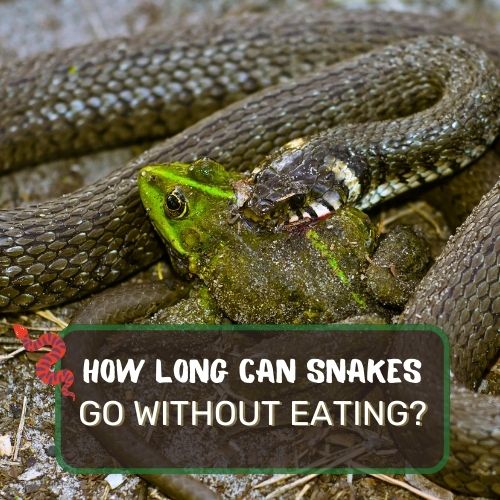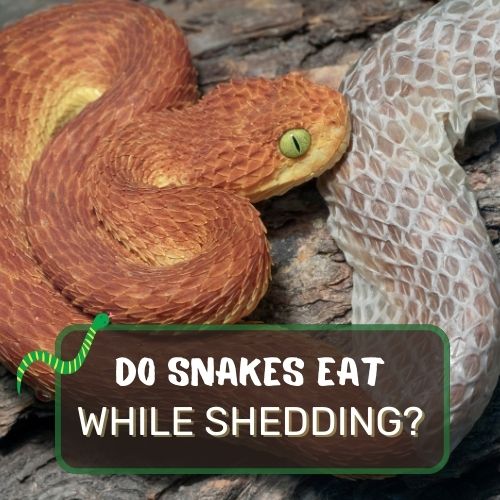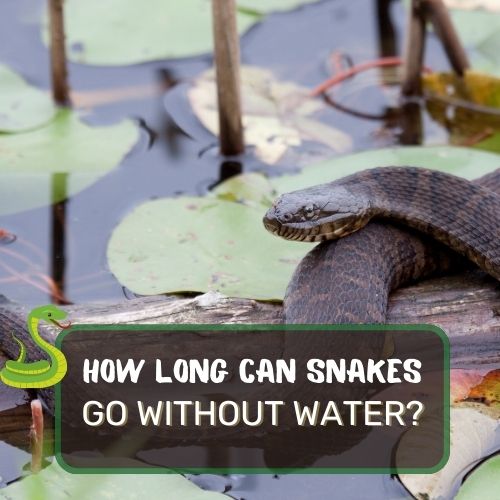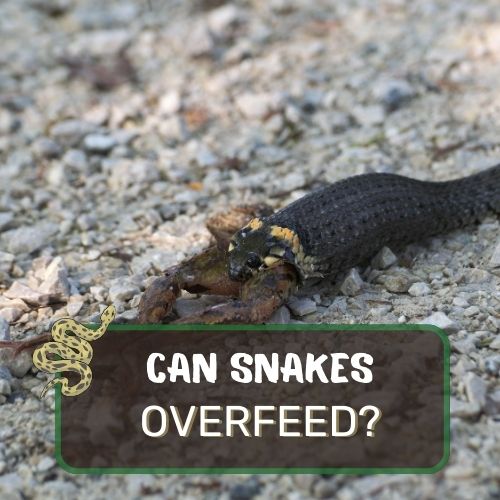
Are you curious about how long can snakes go without eating?
Delve into the intriguing world of snake feeding habits in this article.
Explore the factors that influence their fasting durations, including species variations, age, and environmental conditions.
Discover case studies highlighting the diverse survival strategies of snake species and gain insights into caring for pet snakes.
From ball pythons’ unique captive behaviors to the endurance of wild corn snakes, we’ll unravel the mysteries behind these remarkable creatures’ eating patterns.
Whether you’re an enthusiast or a snake owner, learn valuable tips for understanding and supporting your snake’s dietary needs. Unveil the secrets of their fasting abilities and embark on a journey of fascination and understanding.
Table of Contents
- 1 How long before you need to feed your snake again? (Short Answer)
- 2 Snakes and their Eating Habits
- 3 How Long Can Snakes Go Without Eating?
- 4 Factors That Affect a Snake’s Ability to Go Without Food
- 5 Case Studies and Examples
- 6 Tips for Snake Owners
- 7 Frequently Asked Questions About Snakes and Eating Habits
- 8 Conclusion
How long before you need to feed your snake again? (Short Answer)
The frequency at which you need to feed your snake depends on various factors, including the species of snake, its age, size, health, and the environment it’s in. Generally, snakes can go without eating for several weeks to a few months. Juvenile snakes tend to eat more frequently due to their growth requirements, while adults might have longer intervals between meals. It’s important to research your specific snake species and consult with a veterinarian or experienced reptile keeper to determine the ideal feeding schedule for your pet snake. Monitoring your snake’s health, behavior, and body condition can also help you gauge when it’s time to feed again.
Snakes and their Eating Habits

Snakes, those enigmatic and fascinating creatures, possess a unique feeding pattern that often leaves us wondering just how long they can go without a meal.
From the slithering giants to the pint-sized serpents, their ability to endure periods of fasting is nothing short of remarkable. In this exploration, we delve into the intriguing world of snake feeding habits and the factors that influence their dining schedule.
General Information about Snakes and their Feeding Patterns
Snakes are captivating predators known for their incredible adaptations, and their eating habits are no exception. These legless wonders are carnivores, meaning they primarily feed on other animals, which could range from rodents to birds and even other reptiles.
Their consumption patterns, however, are far from predictable.
While some snakes feed more frequently, others can go astonishingly long durations without a meal. This often raises the question: just how long can these serpents endure without satisfying their hunger?
The answer lies in a myriad of factors that interplay within their ecosystems.
Factors that Influence a Snake’s Feeding Schedule
1. Species of Snake
Snakes come in an astounding variety of species, each with its own unique feeding requirements. For instance, the Burmese python is renowned for its ability to withstand extended periods without eating, sometimes even up to several months.
This resilience can be attributed to their energy-efficient metabolism and large fat reserves, allowing them to endure prolonged fasts in the wild.
Conversely, some smaller snake species may require more frequent meals due to their higher metabolic rates. A garter snake, for example, might need to eat more frequently to maintain its energy levels.
The variation among species showcases the remarkable adaptability of snakes to their environments.
2. Age and Size of the Snake
Age and size play a significant role in a snake’s feeding schedule. Juvenile snakes, being in their growth phase, typically consume more frequently than their adult counterparts. Their rapid growth demands a consistent intake of energy and nutrients.
As they mature, their feeding frequency might decrease, aligning with their metabolic changes.
Larger snakes, owing to their increased body mass, can generally endure longer periods without eating compared to smaller ones. This is due to the fact that they possess higher fat reserves that act as an energy reservoir during times of scarcity.
3. Environmental Factors
The environment in which a snake resides significantly influences its feeding pattern. In regions with seasonal prey availability, snakes have adapted to feast during periods of abundance and endure fasting during scarcity.
This natural ebb and flow allows them to synchronize their feeding habits with nature’s rhythm.
Furthermore, temperature and climate impact a snake’s metabolic rate. Cold-blooded creatures, snakes are heavily reliant on external warmth to maintain their bodily functions.
Cooler temperatures can slow down their metabolism, leading to reduced energy requirements and potentially elongated fasting periods.
How Long Can Snakes Go Without Eating?

The Average Time Snakes Can Go Without Food
Curiosity about how long snakes can endure without a meal often sparks discussions among snake enthusiasts and researchers alike. On average, snakes can typically go without eating for several weeks to a few months.
This remarkable ability is intricately tied to their physiology and the specific circumstances they find themselves in.
Variation in Fasting Periods Based on Snake Species
The duration of fasting varies significantly between different snake species. As mentioned earlier, the Burmese python, with its sizable fat reserves and energy-efficient metabolism, can withstand months of fasting.
This adaptation is particularly useful in the wild where prey availability might be sporadic.
In contrast, some smaller snake species may not have the same luxury of extended fasting. Their metabolism demands more frequent intake of nutrients to sustain their energy levels.
This diversity in fasting capabilities showcases the dynamic range of survival strategies that snakes employ.
Infant Snakes and Their Ability to Go Without Food
Infant snakes, often referred to as neonates, possess a unique set of challenges and adaptations. Just hatched, these young serpents might not possess the same energy reserves as their adult counterparts.
Consequently, many neonates are adept at hunting and consuming prey shortly after birth, despite their diminutive size.
The ability of infant snakes to endure without food is limited by their size, and they usually need to consume more frequently compared to adults. Their fast metabolic rates require a consistent supply of nutrients to support their rapid growth and development.
Factors That Affect a Snake’s Ability to Go Without Food

Metabolic Rate and Energy Conservation in Snakes
A snake’s metabolic rate plays a pivotal role in determining how long it can survive without eating. Snakes are ectothermic, meaning they rely on external sources of heat to regulate their body temperature.
Consequently, cooler environments can slow down their metabolism, conserving energy and extending their fasting endurance.
Seasonal Variations in Feeding Patterns
The changing seasons influence a snake’s feeding habits. In colder months, when prey might be scarce, snakes often enter a state of torpor or reduced activity. During this period, their metabolic rates drop, and they might not require as much sustenance.
As temperatures rise and prey becomes more abundant, their feeding frequency increases to meet their energy demands.
Stress and Its Impact on a Snake’s Appetite
Stress is another factor that can influence a snake’s appetite and feeding schedule. Snakes can experience stress due to various reasons, such as changes in their environment, handling by humans, or encountering predators.
This stress can lead to a decreased appetite and even extended fasting periods as the snake’s body prioritizes survival overfeeding.
Understanding these factors that affect a snake’s ability to go without food provides us with a deeper appreciation for their adaptive strategies.
From metabolic nuances to seasonal shifts and even emotional responses, snakes exhibit a complexity that goes beyond their seemingly simple existence.
Case Studies and Examples

Study 1: Ball Pythons and Their Feeding Schedule in Captivity
Ball pythons, popular among snake enthusiasts, are known for their relatively modest appetite. In captivity, their feeding schedule can vary based on factors like age, health, and individual preferences.
Juvenile ball pythons tend to eat more frequently to fuel their growth, often consuming meals every 1-2 weeks. However, as they mature, their feeding frequency can decrease to once every 2-4 weeks.
Interestingly, ball pythons can also go without food for extended periods when they enter the fasting phase. This phenomenon is not uncommon, and it’s believed to be influenced by factors like temperature, breeding cycles, and environmental changes.
Despite these fasting periods, ball pythons generally maintain their health and vitality.
Study 2: Corn Snakes and Their Ability to Survive Without Food
Corn snakes are known for their adaptability and hardiness. These snakes are frequently studied due to their ability to endure extended periods without eating. In the wild, corn snakes might go weeks without food, especially during colder months or when prey is scarce.
Their metabolism adjusts to these conditions, allowing them to maintain energy levels even during fasting.
In captivity, corn snakes are usually offered regular meals, but they can still exhibit fasting behavior. Similar to ball pythons, fasting in corn snakes can occur for various reasons, including breeding cycles or environmental cues.
These observations shed light on the flexible nature of snake feeding habits.
Study 3: Wild Snakes and Their Extended Fasting Periods
In the wild, many snake species exhibit astonishing fasting endurance, driven by the unpredictability of prey availability. For example, hognose snakes have been observed fasting for several months during winter months when their prey items are scarce.
This adaptive strategy allows them to conserve energy and survive until better feeding conditions arise.
Garter snakes, too, display remarkable fasting ability in the wild. These snakes can endure months without eating, often relying on their fat reserves to sustain themselves.
The ability of various snake species to withstand prolonged fasting in their natural habitats underscores their resilience in the face of adversity.
Tips for Snake Owners

Understanding the Specific Needs of Your Snake Species
One of the most crucial aspects of caring for a pet snake is understanding the dietary requirements of its specific species. Different snakes have varying metabolic rates, feeding preferences, and fasting abilities.
Research your snake’s species thoroughly to determine how often it needs to eat and whether it might exhibit fasting behavior. This knowledge will help you provide the appropriate care and prevent unnecessary stress.
Establishing a Regular Feeding Schedule
Consistency is key when it comes to feeding your snake. Once you’ve determined the optimal feeding frequency for your snake, establish a regular schedule. This routine not only mimics their natural feeding patterns but also helps them adjust their metabolism accordingly.
Avoid overfeeding, as it can lead to obesity and health issues. A well-regulated feeding routine contributes to the overall well-being of your pet.
Monitoring the Health and Appetite of Your Snake
Keep a close eye on your snake’s health and appetite. Sudden changes in behavior, such as refusing food for extended periods, can signal underlying health concerns. While occasional fasting is natural, prolonged loss of appetite might indicate a problem.
Regularly assess their body condition, ensuring they maintain a healthy weight. If you notice any unusual behaviors or signs of illness, consult a veterinarian experienced in reptile care.
Frequently Asked Questions About Snakes and Eating Habits
Can a Snake Go a Week Without Eating?
Yes, many snake species can go a week without eating. Some species can even go much longer without food, thanks to their unique metabolic adaptations. However, factors such as age, health, and environmental conditions can influence this duration.
How Long Can a Lost Snake Go Without Eating?
Lost snakes might enter a state of torpor, reducing their metabolic rate and conserving energy. This allows them to survive for several weeks without food. However, the specific duration varies based on the snake’s size, health, and surrounding temperature.
Can Snakes Go Three Weeks Without Eating?
Yes, many snake species can go three weeks without eating, and even longer. This ability is linked to their metabolism and energy reserves. In some cases, snakes might voluntarily fast for extended periods without experiencing adverse effects.
How Do Snakes Go So Long Without Eating?
Snakes have evolved to adapt to periods of food scarcity. Their efficient metabolism and energy-conserving behaviors, such as reduced activity levels, allow them to stretch their energy reserves. Additionally, their bodies can switch to alternate energy sources, like stored fat, during fasting periods.
Conclusion
In the enigmatic world of snakes, the question of how long they can go without eating unravels a captivating narrative of survival strategies, adaptations, and resilience.
From the Burmese python’s months-long fasting to the corn snake’s flexible approach, these reptiles exhibit an astonishing range of responses to varying conditions.
As responsible snake enthusiasts and pet owners, it’s our duty to delve into their unique needs, habits, and preferences. By understanding the factors influencing their feeding patterns, we can provide them with optimal care and foster their well-being.
Whether it’s monitoring their health, establishing feeding routines, or appreciating the variations among species, the journey into the realm of snakes continues to be an exploration of awe and admiration.
So, next time you find yourself pondering the question of how long snakes can go without eating, remember that the answer is as diverse and dynamic as the creatures themselves—a testament to the marvels of evolution and the intricate web of life that sustains them.




0 Comments